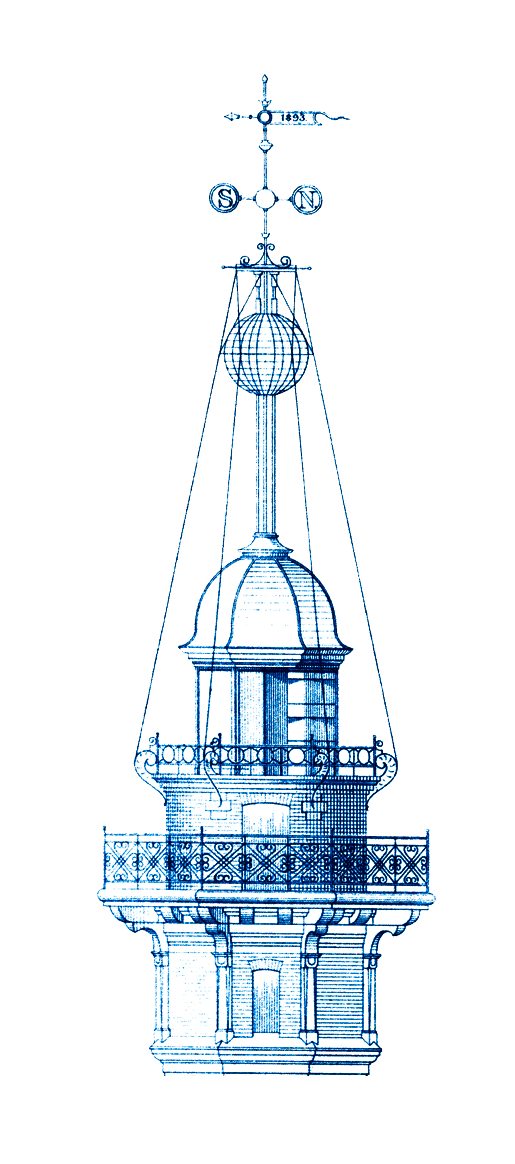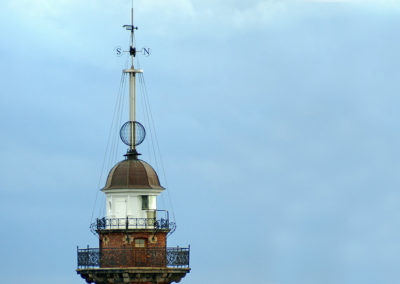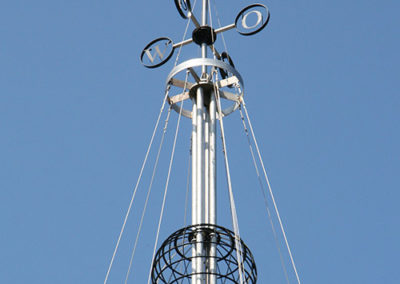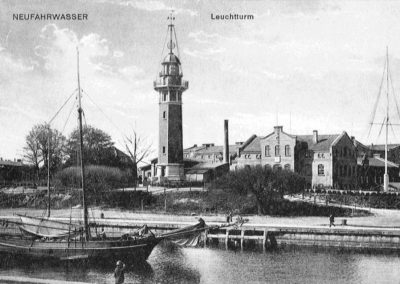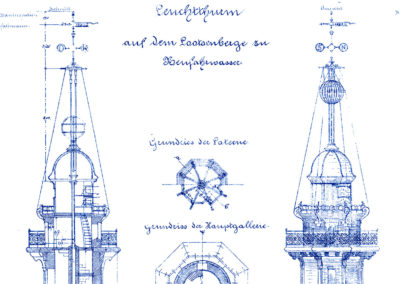
T HE TIME BALL ON GDAŃSK NOWY PORT LIGHTHOUSE
The Gdańsk time ball, the fist on the Baltic, was constructed in 1876 on a special wooden tower. In 1894 it was transferred to the top of the lighthouse at Gdańsk Nowy Port (which, although now a historical building, was then new). At the turn of the twentieth century Marconi’s invention of the radio marked the end of the usefulness of a time ball and when a storm tore off the ball in Gdańsk in 1929 it was not repaired. Today there are only a few time balls remaining in the world, including balls at Greenwich, Washington, Singapore and Lyttelton (New Zealand). In these port cities they are great tourist attractions as monuments to navigational technology in the nineteenth century and symbols of the historical maritime character of these cities. The reconstruction of the Gdańsk time ball was begun in 2006.
The reconstructed time ball has a diameter of 1.6 metres and weighs 75 kilograms. When it remains in its resting position it is 36.5 metres above sea level (27.8 metres from the base of the lighthouse). In its cycle it travels 3.2 metres upwards in two stages and during its fall its mechanism begins to apply a brake just before the end of its course to weaken the impact on the (original) shock absorbers. With its time ball and mast, the lighthouse measures 36 metres from its base. At twelve o’clock noon on 21st May 2008 a ceremonial inauguration took place and the time ball was demonstrated for the first time. During the summer season its fall four times daily is an unusual attraction, as there are only a few such time balls in operation in the world today. Most of them, it should be noted, reconstructed.
The fall of the time ball marks punctually the hours of twelve noon, and two, four and six in the afternoon, according to the extremely accurate DCF77 time-keeping system created at the Physikalisch-Technische Bundesanstalt in Braunschweig and transmitted on the 77.5 kHz long-wave band by the radio station at Mainflingen near Frankfurt-am-Main, a time-pattern whose precision has been defined as one second of acceptable accumulated error in 200,000 years!
THE HISTORY OF THE TIME BALL
The person who came up with the idea for a piece of equipment for the purpose of straightforwardly synchronising chronometers with astronomical time was the Englishman Captain Robert Wauchope (1788-1862). He called his patent a time ball (German Zeitball). The construction was based on the same principle as the so-called “balls” at race courses that signalled the start of a race. The equipment consisted of a mast erected at a visible site with a large cupola that moved up and down it. A time ball had to be about a metre and a half in diameter and to be seen from ships, often lying at a great distance. It was raised by means of a hand winch and fell after the tension was released. For ships’ captains who moored in the River Thames a ball was housed at the Observatory building at Greenwich. Its fall was an accurate signal of one hour after solar noon. The first ball was installed in the English port of Portsmouth in 1829, while that at Greenwich was the second, appearing in 1833.
The earliest stations for time balls could only be at observatories in the immediate neighbourhood so as to guarantee the accuracy of the signal that they gave out. This changed in about 1850, when time signals began to be transmitted by telegraph, and thereafter the Morse system kept stations informed of astronomical noon. Thanks to this development approximately two hundred coastal time balls came into existence worldwide. The time signal reached Gdańsk by telegraphic link from the Berlin Royal Observatory. The first time ball station in the State of Prussia was built in Cuxhaven and in 1875 and 1876 others followed in several large ports, including Gdańsk Nowy Port (then Danzig Neufahrwasser) in 1876.
THE GDAŃSK TIME BALL
In Gdańsk an openwork time ball, operated by postal staff, was secured on a wooden tower and served as a watchtower for the harbour pilots. This tower was adjacent to a higher lighthouse, whose light was first lit in 1758, after the closure of the lighthouse at Wisłoujście. The two towers occupied plots of land on Bliesenstraße (today’s ulica Blizowej, close to the now defunct local railway station of Nowy Port). The mast of the station was about six metres in height and crowned with a weathervane under which was located an indicator of the compass points and below this the time ball itself. Information about the exact hours when it was to fall was perhaps obtainable from the post office window at Neufahrwasser.
We learn from the ordinances dated 7th July 1876 of the imperial director-in-chief of the Post Office in Gdańsk that the time ball had a diameter of a metre and a half, was black and when raised was positioned 28 metres above the mean level of the water and 20 metres above the ground. The ball had a fall of three metres. Ten minutes before each time signal it was hoisted to half-mast and three minutes before the signal to the top of the mast. If the ball did not fall exactly at the designated time another red ball, 40 centimetres in diameter, was hoisted for five minutes on one of the securing cords three minutes after the unsuccessful attempt. If the time ball failed to fall altogether the red ball was hoisted three minutes after the designated time to half the height of the construction, where it remained until the time ball was lowered. Stations in other ports operated in a similar way.
From 1901, when Guglielmo Marconi sent the first radio signal across the Atlantic from the Poldhu Lighthouse in Cornwall to the Signal Hill Lighthouse in Newfoundland, great changes took place in navigation. Time signals began to reach ships on all the oceans of the world by means of radio. By the early twentieth century the time ball had become an anachronism. In Gdańsk a radio station started in 1921 and one of its basic functions was to transmit an accurate time signal each noon. It was probably because of this that after the gale which wrecked it in 1929 there was no need to repair the Gdańsk time ball.
WHAT WAS THE TIME BALL FOR?
The error in the reading of a chronometer, in other words the number of seconds by which the instrument was running fast or slow on a daily scale, is known as the daily rate of the instrument. Chronometers were synchronised most frequently to the time at Greenwich on the River Thames. The key information for calculating the geographical longitude of a ship was what the time was in Greenwich when the solar meridian occurred in a given place. Yet, because it was a mechanical timepiece, even the most precise chronometer often failed to work properly because of such factors as temperature changes, damp and the rolling of the ship. If a clock misread the time by a single second, a ship sailing, for instance, on the Equator would be 460 metres out in defining its position, while an inaccuracy of a minute would make it 28 kilometres out and a misreading of an hour would increase the error to 1670 kilometres. If, then, a marine timepiece deviated by only ten seconds, it would mean that its actual position would differ from the calculated position by 4,6 kilometres (2.5 nautical miles), which would obviously pose a problem for the captain. Setting a chronometer according to the signal of a time ball enabled this to be avoided.
HOW DID THE TIME BALL WORK AT THE NOWY PORT LIGHTHOUSE?
Five minutes before noon the ball was hoisted to half-mast. Three minutes later it travelled all the way to the top, and after another two minutes the signal, speeding by telegraph from the Royal Observatory in Berlin, released the mechanism. The falling ball meant that it was exactly twelve noon in Central European Time and in this way the captains of ships lying in the roads (and everywhere that the ball was visible) could set their marine chronometers accurately.
